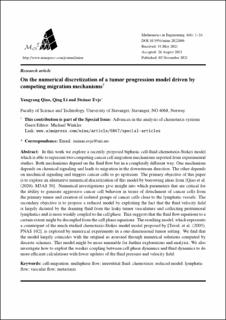| dc.contributor.author | Qiao, Yangyang | |
| dc.contributor.author | Li, Qing | |
| dc.contributor.author | Evje, Steinar | |
| dc.date.accessioned | 2023-02-16T14:01:04Z | |
| dc.date.available | 2023-02-16T14:01:04Z | |
| dc.date.created | 2022-01-05T13:02:56Z | |
| dc.date.issued | 2021 | |
| dc.identifier.citation | Qiao, Y., Li, Q., & Evje, S. (2022). On the numerical discretization of a tumor progression model driven by competing migration mechanisms. Mathematics in Engineering, 4(6). | en_US |
| dc.identifier.issn | 2640-3501 | |
| dc.identifier.uri | https://hdl.handle.net/11250/3051591 | |
| dc.description.abstract | In this work we explore a recently proposed biphasic cell-fluid chemotaxis-Stokes model which is able to represent two competing cancer cell migration mechanisms reported from experimental studies. Both mechanisms depend on the fluid flow but in a completely different way. One mechanism depends on chemical signaling and leads to migration in the downstream direction. The other depends on mechnical signaling and triggers cancer cells to go upstream. The primary objective of this paper is to explore an alternative numerical discretization of this model by borrowing ideas from [Qiao et al. (2020), M3AS 30]. Numerical investigations give insight into which parameters that are critical for the ability to generate aggressive cancer cell behavior in terms of detachment of cancer cells from the primary tumor and creation of isolated groups of cancer cells close to the lymphatic vessels. The secondary objective is to propose a reduced model by exploiting the fact that the fluid velocity field is largely dictated by the draining fluid from the leaky tumor vasculature and collecting peritumoral lymphatics and is more weakly coupled to the cell phase. This suggests that the fluid flow equations to a certain extent might be decoupled from the cell phase equations. The resulting model, which represents a counterpart of the much studied chemotaxis-Stokes model model proposed by [Tuval, et al. (2005), PNAS 102], is explored by numerical experiments in a one-dimensional tumor setting. We find that the model largely coincides with the original as assessed through numerical solutions computed by discrete schemes. This model might be more amenable for further explorations and analysis. We also investigate how to exploit the weaker coupling between cell phase dynamics and fluid dynamics to do more efficient calculations with fewer updates of the fluid pressure and velocity field. | en_US |
| dc.language.iso | eng | en_US |
| dc.publisher | AIMS Press | en_US |
| dc.rights | Navngivelse 4.0 Internasjonal | * |
| dc.rights.uri | http://creativecommons.org/licenses/by/4.0/deed.no | * |
| dc.title | On the numerical discretization of a tumor progression model driven by competing migration mechanisms | en_US |
| dc.type | Peer reviewed | en_US |
| dc.type | Journal article | en_US |
| dc.description.version | publishedVersion | en_US |
| dc.rights.holder | The authors | en_US |
| dc.subject.nsi | VDP::Matematikk og Naturvitenskap: 400 | en_US |
| dc.subject.nsi | VDP::Medisinske Fag: 700 | en_US |
| dc.source.pagenumber | 1-24 | en_US |
| dc.source.volume | 4 | en_US |
| dc.source.journal | Mathematics in Engineering | en_US |
| dc.source.issue | 6 | en_US |
| dc.identifier.doi | 10.3934/mine.2022046 | |
| dc.identifier.cristin | 1975129 | |
| cristin.ispublished | true | |
| cristin.fulltext | original | |
| cristin.qualitycode | 1 | |

